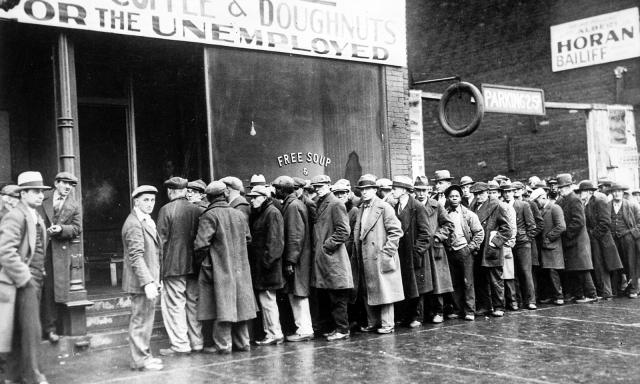

 Article
Article

 The stock market crash, Gatsby’s parties, the New Deal, President Hoover and the actual timeline: So that we might learn from history, an expert in financial crises corrects some common misconceptions about the Great Depression.
The stock market crash, Gatsby’s parties, the New Deal, President Hoover and the actual timeline: So that we might learn from history, an expert in financial crises corrects some common misconceptions about the Great Depression.

Insights from
October will mark the 90th anniversary of the stock market crash of 1929. The Great Crash was followed by the Great Depression, a seminal moment in history — a very long moment, with effects that lingered.
To learn from history, it can be helpful to look at what happened — and also what did not happen.
Darden Dean Emeritus Bob Bruner, a financial economist and expert on financial crises and enterprise leadership, offers some counterintuitive insights and corrects common misconceptions that abide, even with contemporary economists.
The parties of The Great Gatsby may have us believe, 94 years after its publication, that consumerism and extravagance were the norm in the Roaring ’20s. Popular lore accused the decade of similar financial indulgence and irresponsibility: easy credit, overvalued stocks, an abundance of risky market speculation, inflation. But the 1920s also saw low price inflation, economic growth motivated by a manufacturing revolution, and many stock prices that reflected reasonable expectations. The case for financial excesses in the 1920s as the cause of the crash and depression is surprisingly weak.
While the 1929 crash may have deepened the problem, it was not necessarily the cause of the years of global depression that followed. The Great Depression had more to do with the impossible terms that ended the Great War. In the wake of World War I, European nations pegged their currencies to unrealistic exchange rates with gold. Protectionism and nationalism rigged the formerly free flows of capital and trade across borders. The Federal Reserve kept interest rates low, but in 1928 and 1929 raised rates, prompting economic activity to decline. And when the Central Powers failed to make reparations payments, their European neighbors found it difficult to repay those war debts to the U.S.
Trouble was brewing before Black Tuesday.
The Depression hit on Herbert Hoover’s watch, and his presidency didn’t survive more than the one term; he was succeeded by Franklin Delano Roosevelt, who was vocal about the inaction of “Republican leaders.” But Hoover wasn’t ignoring the problem. He cut taxes, increased spending in public works and negotiated to keep work and wages going, all on the tail of the crash. When the country’s problems worsened, he tried many more big-scale tactics. But his efforts may have fallen short in winning public enthusiasm for his methodology and public approval for himself.
Maybe you can accuse him of bad PR. But he wasn’t twiddling his thumbs.
FDR was far better than his predecessor at drumming up public confidence. Slow recovery began after he took office. And FDR’s New Deal did set a new high mark for “bold, persistent experimentation” in public policy. But it was not single-handedly responsible for ending the Depression. The nation didn’t achieve pre-depression conditions for years, and scholars have argued that numerous other forces had more significant impact. To name a few: the Fed’s monetary policy, easing of global trade and currency restrictions, and industrial expansion in World War II. Some experts have even suggested that the New Deal’s policies extended the length of the Depression. Despite (or because of) the intractability of recovery, FDR shifted his attention during his second term from the New Deal to the worsening international conditions.
Historians highlight FDR’s New Deal as an energetic response to the economic catastrophe. Yet in several ways it worked at cross-purposes to the recovery it sought to achieve.
1939 is widely considered the end of the Great Depression. But privations lingered into the 1940s when the country finally saw material improvements in traditional indicators of prosperity: national consumer spending (back to 1929’s level in 1941), unemployment (still more than 15 percent in 1939), and marriages and birthrates (returned to the level of the 1920s after 1946).
It’s tempting to bookend a phenomenon like the Depression with two events 10 years apart: the crash of 1929 on the front end and the beginning of World War II on the other. But history isn’t always that tidy.
For more on details on the Great Depression and misconceptions about it, please see Robert F. Bruner’s “5 Myths About the Great Depression” in The Washington Post.
Bruner is an expert on mergers and acquisitions. He’s written two books on the subject, Deals From Hell: M&A Lessons That Rise Above the Ashes and Applied Mergers and Acquisitions, which have helped countless students and business people deal with the complexity of mergers and acquisitions. His business expertise is wide-ranging; he’s well-versed in corporate finance, financial crises and bank panics, corporate valuation, enterprise leadership and management education. He is co-author of Case Studies in Finance: Managing for Corporate Value Creation, currently in its eighth edition.
Bruner comments on life, business and current events in his blog. He also tweets on his Twitter account.
B.A., Yale University; MBA, DBA, Harvard University